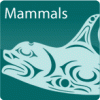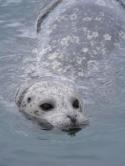HABITAT:
Harbour seals live in coastal waters and on rocky shores.
DIET:
Harbour seals are opportunistic feeders. They eat flounder, sculpin, hake, cod, herring, octopus, and squid.
PREDATORS:
Transient Killer Whales
Identification
Size & Shape:
Male harbour seals weigh 90 - 114 kg , females weigh 68 - 90 kg, and seal pups weigh 5.5 - 9 kg.
Male harbour seals are 1.5 - 1.7 m in length, females are 1.2 - 1.4 m, and pups are usually less than a metre long.
Harbour seals have a compact body with short pectoral and hind flippers. Their pectoral flippers can barely touch the ground and the hind flippers are fused, which makes it hard for them to move around on land.
Distinctive Markings:
Colouration of a harbour seal is variable, ranging from black and tan with mottled patterns of light or dark spots on some parts of their body. Harbour seals are not sexually dimorphic; there is no large significant difference is size between males and females.
Behavior:
Harbour seal haul out on rocks during low tide and occurs at specific sites that are used on a daily basis. When hauled out, harbor seals often lie with their heads and hind flippers elevated in what is often referred to as banana boating. When resting in water, harbor seals can be seen in what we call the "bottling" position, with heads tilted straight back and perpendicular to the surface; thus assuming the appearance of a floating bottle.
Life History
Habitat:
Coastal waters and rocky shores
Conservation:
As a higher predator, the harbour seal is an important indicator species. The health of harbour seal populations can tell us a lot about the health of our marine ecosystems. Predators help to control the populations of their prey, which is important for the overall function of the food web.
Pollution
-High concentrations of PCB's
Harbour seals are vulnerable because they feed high on the food chain, consuming prey that have bioacummulated with these long-lasting contaminants. This is of concern because harbour seals in the Salish Sea have been found to carry some of the highest concentrations in the world. These high levels of pollutants can affect reproduction.
Reproduction:
LONGEVITY:
20-25 years
MATURE:
Males - 4 - 6 years
Females - 3 - 5 years
NUMBER OF PUPS:
1
GESTATION:
9 - 10 months (delayed implantation)
Courtship and mating take place underwater, but their young are born on land.
Did you know?:
- Mother seals leave their pups for upto 12 hours at a time to forage for food
- Scientists can identify individual seals by their mottling pattern (spots on their body)
First Nations
description:
Harbour seals were hunted by First Nations of B.C. for their pelts, meat and oil. A small number of animals are still taken in subsistence hunting. Between 1900 and the early 1960s, harbour seals were hunted commercially and to reduce competition with humans for commercial fish stocks. The Department of Fisheries and Oceans offered a bounty on seals between 1913 and 1964, causing populations to decline substantially. The Fisheries Act now prevents killing of harbour seals except with a permit. As a result, populations of harbour seals have closely returned to historic levels.







